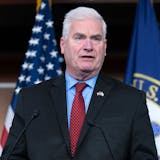Thanks to Minneapolis Mayor Jacob Frey's recent press conference about the future of riverfront development, urbanists of all stripes are reconsidering the downtown post office. Everyone agrees it should be reconnected to downtown.
Well, it once was connected, but downtown wasn't particularly interested.
That's back when the area along the west side of the Mississippi River was tired and sooty. A big warehouse, some class-C office space, some two-story retail, a flophouse or three. When it opened in 1934, the new post office was certainly impressive, but it never had the draw of a theater or department store. Despite its stunning interior, a post office, after all, is a place of everyday commerce, a place where you have to go, not necessarily want to go.
On paper, the post office project looked noble and inspirational, sort of an early example of urban renewal. Where old brick commercial buildings had once crowded the street, there was now a broad new wall of a building in the severe, rational style of the era.
The architect was Léon Eugène Arnal, who'd been the lead on the Foshay Tower a few years earlier. If that building's interior was the last draught of fizzy Art Deco aesthetics, tipsy and frivolous, the new post office was a serious statement of power and confidence.
The post office faced a sizable park: an entire block of grass and trees standing in line like soldiers. Two pairs of sidewalks led to an octagonal flower bed in the center of the park; from the flower bed, diagonal walkways opened like arms to embrace the post office.
Early proposals for the post office called for a monument in the center of the park, with stylized American Indians, settlers and pioneer women around an obelisk topped by an eagle. That monument was never built.
In 1936, however, the park became the home for a gift from the Pillsbury family: a statue called "Pioneers." Three generations hewn from granite, staring hard into the distance. The statue gave the park its name: Pioneer Square.



